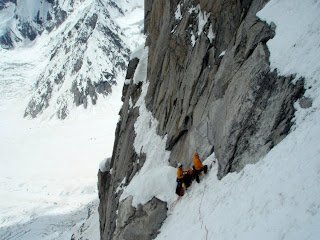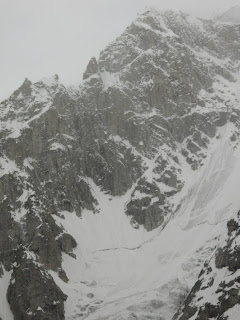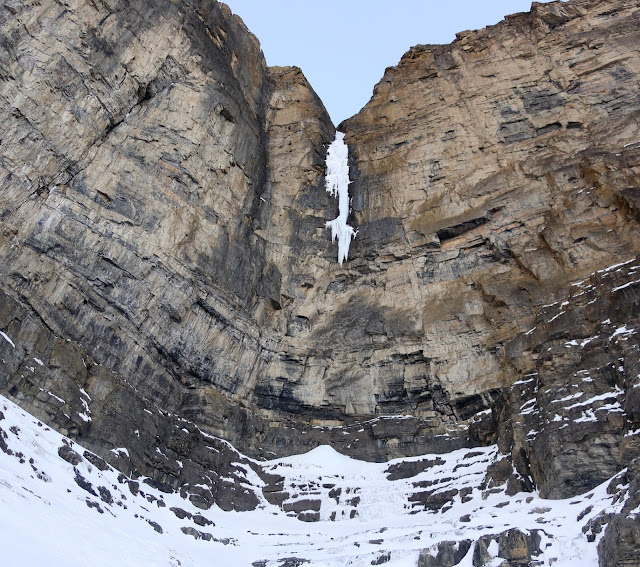Adventures of the 2009 Canadian Pumari Chhish East Expedition
It has been some months since Eamonn, Ian and I returned from Pakistan. As such, the report below is not exactly breaking news. Still, I thought I would kick off my blog with it, as some people might enjoy reading it.
In the summer of 2009, three of us Canadian Rockies locals (Eamonn Walsh, Ian Welsted and I) traveled to Pakistan to play in the bigger hills over there. We returned to the Hispar Glacier area, a region we first visited in 2006 when we unsuccessfully attempted the southwest face of Kunyang Chhish East (ca. 7400 m). Even though Kunyang East is one of the most beautiful mountains I have ever seen (and remains unclimbed to boot), in 2009 we decided to experience another mountain: the (also unclimbed) Pumari Chhish East (ca. 6900).
We left Calgary on June 10th, and on summer solstice arrived in basecamp at 4500 m, a wonderful grassy spot perched above the Jutmaru Glacier. While basecamp had great lounging, bouldering and even some decent cragging, it also offered a front-row view of our objective to remind us of why we were there. The first order of business was to acclimatize, and so already on June 26th we summitted a previously unclimbed 5900-m peak in an 11-hour round trip from basecamp (most of the smaller and not a few of the bigger peaks in the Hispar Glacier area are still unclimbed). We named the peak Rasool Sar in honour of our cook, guide and friend, Hajji Ghulam Rasool. While most of the “climbing” on Rasool Sar consisted of slogging up a steep snow slope, there was an amusing bit of corniced ridge near the top. A few more acclimatization outings, with three nights spent above 5600 m and one foray above 6000 m, and we declared ourselves ready for the main attraction.
Initially we had planned to attempt Pumari Chhish East via its south ridge, first tried in 2007 by Steve Su and Pete Takeda. But after wallowing in horrible snow on a few ridge climbs (bad snow is something most Karakorum ridges I have experienced seem to share), the corniced south ridge lost much of its appeal and we turned our attention to the southeast face to its right. On July 16th we bivied at below the face at 4800 m. The following morning we got going well before dawn to take advantage of cooler temperatures. We made good progress up snow and ice fields, followed by a beautiful ice hose, to the base of the rock headwall at 5700 m. While Eamonn prepared a tent platform, Ian and I did one more pitch of reasonably difficult mixed climbing. Leaving a rope fixed, we descended to a deluxe bivi and a waiting dinner. While the terrain above our highpoint looked hard, it was perhaps not impossibly so, even for lightweights like ourselves. Unfortunately we never did get to come to grips with it: the effort of a big day, the altitude, but above all a heavy meal of freeze-dried chili and cheese had me throwing up all night. In the morning I could barely stand, and so down we went.
On June 28th Ian and I (Eamonn having left to drink beer in Ireland) once again packed our packs and approached the foot of the southeast face. Unfortunately during the intervening ten days of warm weather the ice hose we climbed on the first attempt had melted out. While we sat trying to decide whether we should still attempt the face under present conditions (after all, the word in ice climbing these days is that “it don’t have to be formed to be formed”), a large wet-snow avalanche swept the gully in question. The very same evening we were back in basecamp.
In between the two attempts (if they could be called that) on Pumari Chhish East, the three us climbed a route on a ca. 6300-m peak almost directly above basecamp. On July 20, starting from a bivi at 4900 m below the southwest face of the peak, we soloed some 900 m of serac-threatened snow and ice to reach a steep rock wall streaked with ice smears. We climbed it in some 8 long, sustained ropelengths to reach the summit ridge at 6200 m. Unfortunately the late hour, deteriorating weather but mostly horrible snow conditions (waist-deep crud over rock slabs and hard ice) combined to turn us around. We rappelled through the night and arrived back at our bivi site 22 hours after setting out. While we did not tag the summit, we were psyched to have established one of the best alpine mixed routes any of us has ever done (and this coming from a crew with routes like the Wild Thing, the Moonflower Buttress and Denali Diamond on their resumes). We also took the liberty of naming the still unclimbed peak “Lunda Sar”, which roughly translates as “Second-Hand Peak”.
Finally, just a few days before leaving basecamp and heading back home, Ian and I made the first ascent of Khani Basa Sar (6441 m), a reasonably major peak on the ridge separating the Jutmaru and Khani Basa Glaciers. The peak had been attempted before by several different expeditions; in fact on an earlier acclimatization foray up its south ridge we came across traces of a Korean expedition.
Leaving our bivi at 4800 m at the ungodly hour of 3 in the morning, we made for the southwest rib of the peak, which neatly separates two couloirs capped by giant seracs. After a few worrying moments, when we thought that while stumbling around in the dark we might have blundered into one of the aforementioned gullies, we decided we were in fact on route and continued up pleasant névé and rock scrambling. Shortly after dawn we roped up at a short mixed wall, and continued above on 55-degree ice. The crux of the route was a narrow bit of snow ridge (of course!) leading to the summit plateau. One serac wall especially proved troublesome, but after I took a lead fall (and landed on a pleasantly soft snow mushroom) when my tools ripped out of overhanging fluff, we managed to get up it. After a short brew stop, we continued upward on much easier terrain. We summitted around 6 in the evening, and were rewarded with a panoramic view of the Karakoram, K2 included. The descent was not entirely straightforward, especially reversing the snow ridge, but we persevered and stumbled back to our bivi exactly 24 hours after leaving it.
I highly recommend the Jutmaru Glacier area at the foot of the Pumari Chhish massif: it is a wild, deserted and awesome place. There is no shortage of things to do, either: from granite bouldering around basecamp to super-alpine objectives on the south faces of Pumari Chhish. In either category our expedition has barely scratched the surface of what is possible.
Our expedition was supported by the John Lauchlan Memorial Award. We are honoured to have been chosen to receive this prestigious award, which commemorates one of Canada’s most visionary climbers.
Ian Welsted with a friendly local in the pastures above Karimabad.
In the summer of 2009, three of us Canadian Rockies locals (Eamonn Walsh, Ian Welsted and I) traveled to Pakistan to play in the bigger hills over there. We returned to the Hispar Glacier area, a region we first visited in 2006 when we unsuccessfully attempted the southwest face of Kunyang Chhish East (ca. 7400 m). Even though Kunyang East is one of the most beautiful mountains I have ever seen (and remains unclimbed to boot), in 2009 we decided to experience another mountain: the (also unclimbed) Pumari Chhish East (ca. 6900).
The Kunyang Chhish (left) and Pumari Chhish massifs.
We left Calgary on June 10th, and on summer solstice arrived in basecamp at 4500 m, a wonderful grassy spot perched above the Jutmaru Glacier. While basecamp had great lounging, bouldering and even some decent cragging, it also offered a front-row view of our objective to remind us of why we were there. The first order of business was to acclimatize, and so already on June 26th we summitted a previously unclimbed 5900-m peak in an 11-hour round trip from basecamp (most of the smaller and not a few of the bigger peaks in the Hispar Glacier area are still unclimbed). We named the peak Rasool Sar in honour of our cook, guide and friend, Hajji Ghulam Rasool. While most of the “climbing” on Rasool Sar consisted of slogging up a steep snow slope, there was an amusing bit of corniced ridge near the top. A few more acclimatization outings, with three nights spent above 5600 m and one foray above 6000 m, and we declared ourselves ready for the main attraction.
Rasool in basecamp with Pumari Chhish in the background. Photo: Ian Welsted.
Initially we had planned to attempt Pumari Chhish East via its south ridge, first tried in 2007 by Steve Su and Pete Takeda. But after wallowing in horrible snow on a few ridge climbs (bad snow is something most Karakorum ridges I have experienced seem to share), the corniced south ridge lost much of its appeal and we turned our attention to the southeast face to its right. On July 16th we bivied at below the face at 4800 m. The following morning we got going well before dawn to take advantage of cooler temperatures. We made good progress up snow and ice fields, followed by a beautiful ice hose, to the base of the rock headwall at 5700 m. While Eamonn prepared a tent platform, Ian and I did one more pitch of reasonably difficult mixed climbing. Leaving a rope fixed, we descended to a deluxe bivi and a waiting dinner. While the terrain above our highpoint looked hard, it was perhaps not impossibly so, even for lightweights like ourselves. Unfortunately we never did get to come to grips with it: the effort of a big day, the altitude, but above all a heavy meal of freeze-dried chili and cheese had me throwing up all night. In the morning I could barely stand, and so down we went.
Pumari Chhish East. Photo: Ian Welsted.
Eamonn Walsh (left) and Ian Welsted on the Pumari Chhish East attempt.
Raphael Slawinski starting up the rock headwall on Pumari Chhish East. Photo: Ian Welsted.
Eamonn Walsh brewing up at the bivi on Pumari Chhish East. Photo: Ian Welsted.
On June 28th Ian and I (Eamonn having left to drink beer in Ireland) once again packed our packs and approached the foot of the southeast face. Unfortunately during the intervening ten days of warm weather the ice hose we climbed on the first attempt had melted out. While we sat trying to decide whether we should still attempt the face under present conditions (after all, the word in ice climbing these days is that “it don’t have to be formed to be formed”), a large wet-snow avalanche swept the gully in question. The very same evening we were back in basecamp.
In between the two attempts (if they could be called that) on Pumari Chhish East, the three us climbed a route on a ca. 6300-m peak almost directly above basecamp. On July 20, starting from a bivi at 4900 m below the southwest face of the peak, we soloed some 900 m of serac-threatened snow and ice to reach a steep rock wall streaked with ice smears. We climbed it in some 8 long, sustained ropelengths to reach the summit ridge at 6200 m. Unfortunately the late hour, deteriorating weather but mostly horrible snow conditions (waist-deep crud over rock slabs and hard ice) combined to turn us around. We rappelled through the night and arrived back at our bivi site 22 hours after setting out. While we did not tag the summit, we were psyched to have established one of the best alpine mixed routes any of us has ever done (and this coming from a crew with routes like the Wild Thing, the Moonflower Buttress and Denali Diamond on their resumes). We also took the liberty of naming the still unclimbed peak “Lunda Sar”, which roughly translates as “Second-Hand Peak”.
The southwest face of Lunda Sar. Photo: Ian Welsted.
Raphael Slawinski (left) and Eamonn Walsh slogging up the lower snow and ice slopes on Lunda Sar. Photo: Ian Welsted.
Raphael Slawinski approaching the technical crux on Lunda Sar. Photo: Ian Welsted.
Eamonn Walsh beginning the first of many rappels on Lunda Sar.
Finally, just a few days before leaving basecamp and heading back home, Ian and I made the first ascent of Khani Basa Sar (6441 m), a reasonably major peak on the ridge separating the Jutmaru and Khani Basa Glaciers. The peak had been attempted before by several different expeditions; in fact on an earlier acclimatization foray up its south ridge we came across traces of a Korean expedition.
Leaving our bivi at 4800 m at the ungodly hour of 3 in the morning, we made for the southwest rib of the peak, which neatly separates two couloirs capped by giant seracs. After a few worrying moments, when we thought that while stumbling around in the dark we might have blundered into one of the aforementioned gullies, we decided we were in fact on route and continued up pleasant névé and rock scrambling. Shortly after dawn we roped up at a short mixed wall, and continued above on 55-degree ice. The crux of the route was a narrow bit of snow ridge (of course!) leading to the summit plateau. One serac wall especially proved troublesome, but after I took a lead fall (and landed on a pleasantly soft snow mushroom) when my tools ripped out of overhanging fluff, we managed to get up it. After a short brew stop, we continued upward on much easier terrain. We summitted around 6 in the evening, and were rewarded with a panoramic view of the Karakoram, K2 included. The descent was not entirely straightforward, especially reversing the snow ridge, but we persevered and stumbled back to our bivi exactly 24 hours after leaving it.
The southwest rib of Khani Basa Sar. Photo: Ian Welsted.
Raphael Slawinski halfway up as the sun comes up. Photo: Ian Welsted.
Raphael Slawinski starting up a nasty little serac wall. Photo: Ian Welsted.
Ian Welsted at a brew stop a couple of hours below the summit of Khani Basa Sar.
Ian Welsted taking the last few steps to the summit of Khani Basa Sar.
I highly recommend the Jutmaru Glacier area at the foot of the Pumari Chhish massif: it is a wild, deserted and awesome place. There is no shortage of things to do, either: from granite bouldering around basecamp to super-alpine objectives on the south faces of Pumari Chhish. In either category our expedition has barely scratched the surface of what is possible.
Looking southeast from Khani Basa Sar.
Our expedition was supported by the John Lauchlan Memorial Award. We are honoured to have been chosen to receive this prestigious award, which commemorates one of Canada’s most visionary climbers.




















Comments
Post a Comment